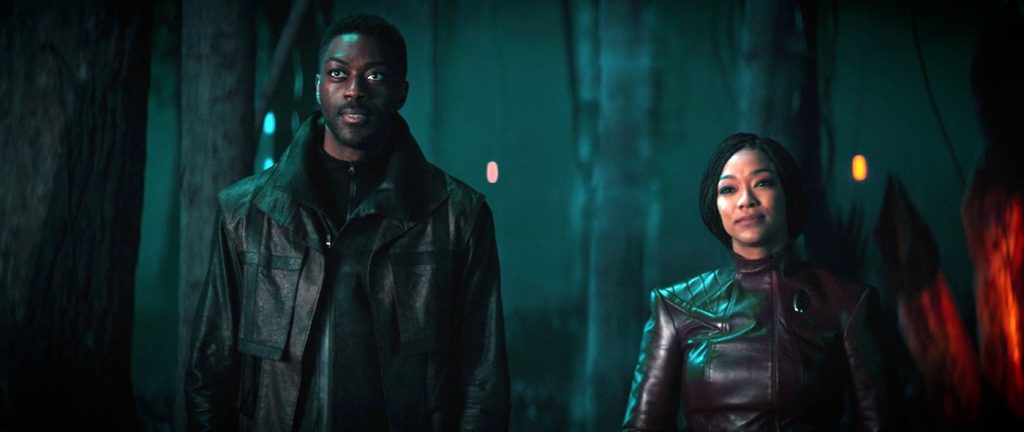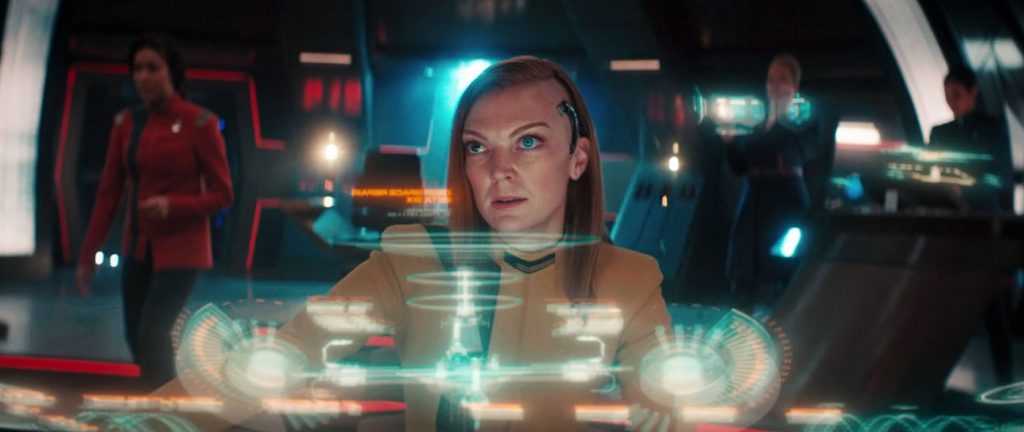Star Trek Discovery returned with the opening episode for season 4 on November 18th. Though this is the first time I’m writing about Discovery for Big Shiny Robot, I’m very excited to start.
Season 3 ended with Michael rightfully occupying the captain’s chair and quickly settling on a catchphrase: let’s fly.
And “Kobayashi Maru” flew straight toward classic Trek themes with great success.
Though Discovery doesn’t belabor explaining what the Kobayashi Maru is, it is a test cadets take while in the Academy, deliberately designed for failure. Though various series interact with the test differently, it is designed to test a captain’s ability to navigate the potential for death–not just their own, but of their crew as well. Kirk, in his various incarnations, states that he doesn’t believe in no win scenarios, and only beats the test by reprogramming it.

The episode opens with Michael and Book attempting to establish diplomatic relationships with a group of people called the Alshain. It demonstrates the type of leader Michael is — someone who refuses to fire back even as they are running for their lives from the Alshain. It’s Michael who realizes the only reason they haven’t been shot out of the sky is because there is something wrong with the Alshain’s technology. Even as Book says that “Not every moment is a victory,” Michael works tirelessly to find an option that does not involve firing back. Ultimately, the Discovery crew resolve the issue and leave dilithium as a parting gift, even though the Alshain have not agreed to join the Federation of Planets or even apologized for the way they treated Book and Michael. It’s implied there’s a history there between the Alshain and the Federation, which isn’t given any great detail. I think this moment does a great job pointing towards the kind of captain Michael is, who did turn the incident with the Alshain into a victory from a certain point of view, while also preparing for the rest of the episode, and Michael’s own Kobayashi Maru.
They return to reopen the Academy and meet the new president of the Federation, who insists on coming along on a rescue mission to Michael’s great reluctance. A mysterious event causing gravity distortions has caused great damage to a repair station. As a result of the distortion, methane ice is carried into the area shortly after Discovery arrives to repair and rescue. It’s essentially a hail storm on steroids, and Discovery extends its shields around both ship and station. Doing so will drain a lot of power, but Michael makes the order without hesitation saying, “We’ll figure it out.” Michael goes on a solo mission against the President’s wishes to remove debris blocking an escape shuttle. Even when the shields won’t last in time for the escape shuttle to make it back to Discovery, Michael refuses to leave anybody behind and they barely escape.

At the end of it all, Michael’s plan worked, though there were some fatalities that she clearly takes to heart. However, the President has a conversation with Michael that thematically circles what the Kobayashi Maru is all about, and how each captain must interact with the principles of that test.
Michael says, “I lead to bring everyone home.” Later, the president says this is a pathological need to save everyone Michael can, and that leading from a place of personal need puts people in harm’s way.
But, before that moment, the president replies, “Leadership is about balance. Knowing what weight is yours to carry and what isn’t.” She goes on to describe that Michael risked the lives of the many to save the lives of a few, and that even though Michael succeeded this time–there would be a time where she wouldn’t, and it shows lack of experience as a captain.
Especially in preceding seasons, Michael did weigh herself down with things that were beyond her control. One of the beautiful things about season three was seeing Michael moving free of that. Michael also doesn’t mindlessly accept this criticism. She does point out that she does have experience–that she and Discovery did a lot to bring them to this moment, this path where anything is possible–except, apparently, a certain style of leadership. Michael challenges this, and I loved every moment.

It firmly plants Captain Burnham within the legacy of Captain Kirk, while still making it entirely hers. Whereas Kirk doesn’t believe in no win scenarios, Burnham leads to bring everyone home. It’s a slight distinction, a minor shift in a framework of perspective, but it is a positive statement over a negative statement–and that also opens a whole new world of possibility.
As with most Trek series, Discovery can miss the colonization aspects that are baked into a lot of western science fiction. Where no one has gone before is a beloved line repeated at the Academy celebrations, but misses the reality that these are inhabited worlds that they are meeting and hopefully befriending. In some ways, Discovery does realize this truth though as Saru challenges his fellow Kelpiens as to what their next steps should be–whether they should remain on their planet, thriving underneath their sun, or something else. “It is not our sun,” he says because they share it with other planets in their system. His point emerges to honor the interconnection with whom they share their galaxy.
It’s a moment, an idea, that really shines towards ideas that Trek has been striving for since its inception.
I’ve often said that Discovery feels like great science fiction, but it doesn’t always feel like Star Trek as it struggled to make itself unique from its predecessors, to escape the long shadows of Kirk and Spock and the rest. That feeling has dissipated season after season, and the hope that embodies Trek’s beating heart was on full display here in this first episode of season four.
I cannot wait to see Michael as captain of Discovery. It’s been such a long time coming.